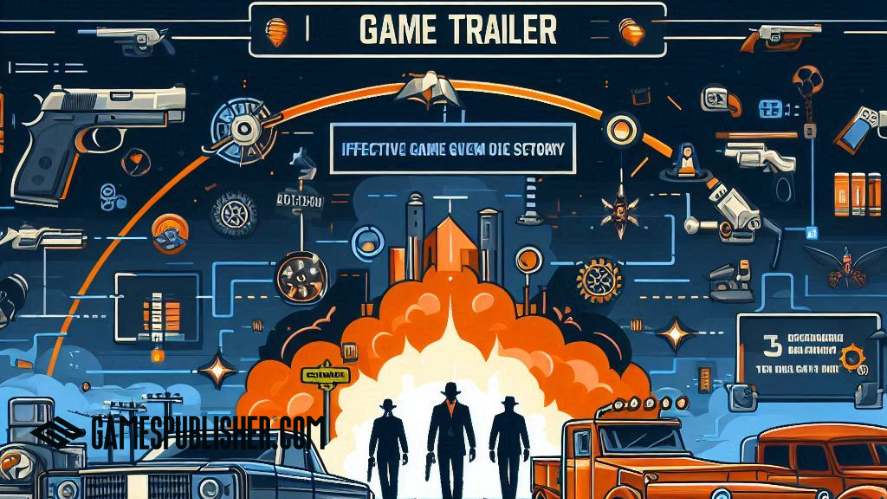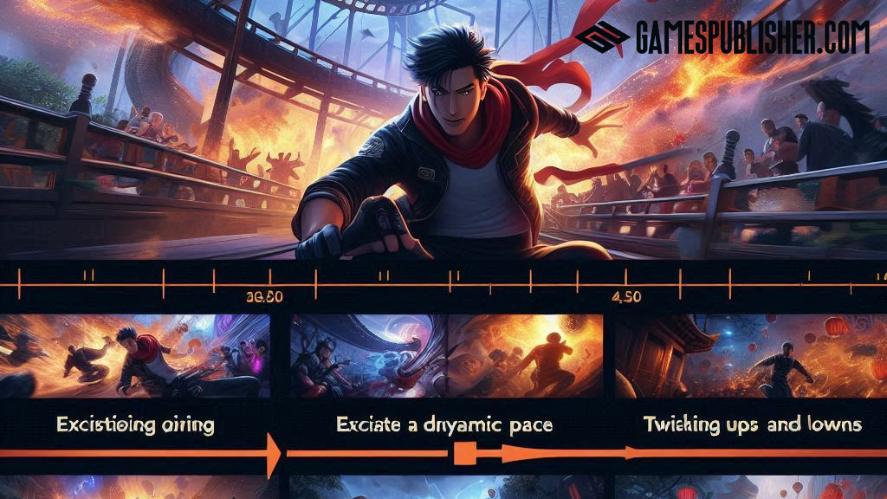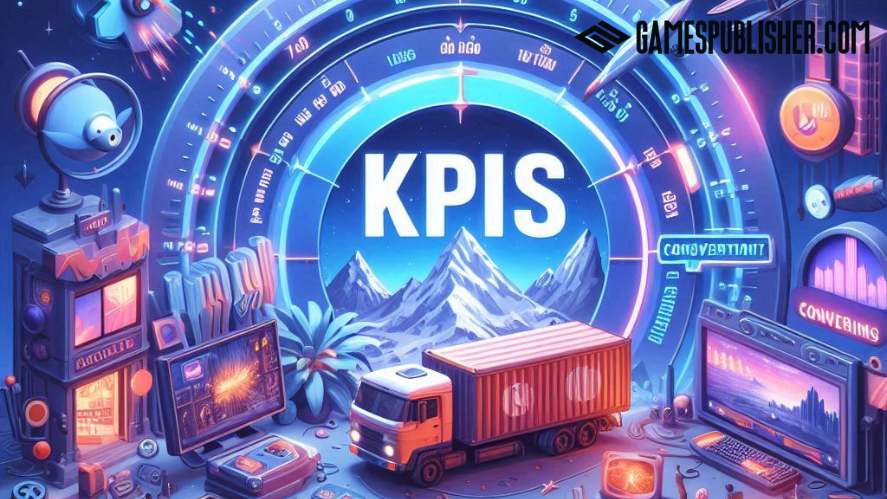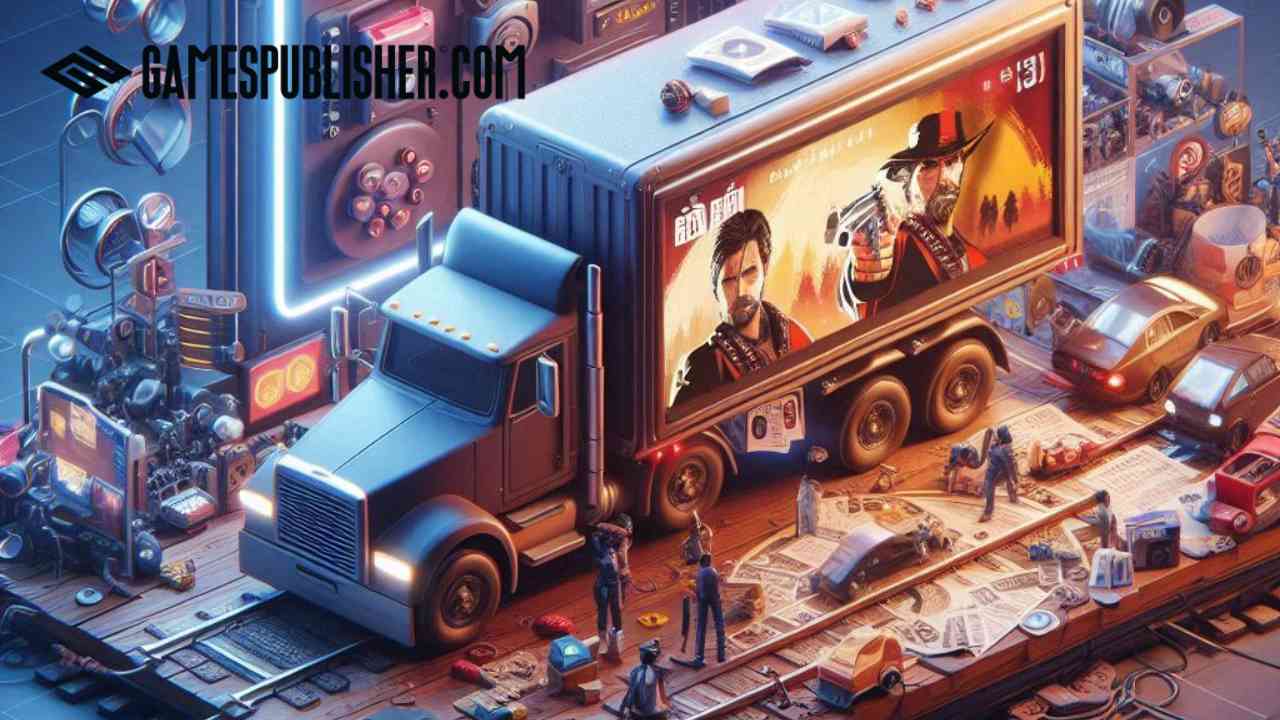Let’s face it: in the cutthroat world of gaming today, a killer game trailer isn’t just a nice-to-have – it’s practically a must.
A top-notch trailer is the cornerstone of any successful game development and launch that will make waves. Think of it as your secret weapon for grabbing the attention of gamers and the media.
For any game developer or video game publisher looking to leave their mark on the gaming industry, a high-quality trailer is not only pure gold in the gaming industry but also plays an essential role for any game publisher.
In this article, we will summarize the essentials of crafting a game trailer that genuinely delivers.
Understanding the Role of a Game Trailer
In the competitive world of video game trailers, a captivating preview can be the difference between a smash hit and a forgotten title.
What Makes a Game Trailer Effective?
An effective game trailer transcends mere gameplay footage, encapsulating the essence of the gaming experience.
Compelling narratives, impactful visuals, and strategic pacing are crucial to creating a trailer that resonates with viewers. Showcasing unique features that distinguish the game from other video game trailers is vital.

Visual engagement through stunning graphics and dynamic camerawork leaves a lasting impression.
The Elden Ring trailer exemplifies this, masterfully blending cinematics and gameplay to highlight the game’s vast world and captivating lore.
How Trailers Impact Sales and Press Coverage
A well-crafted game trailer can do more than just generate views. In fact, it can directly influence a game’s success.
Think of a game trailer as a movie trailer: a captivating preview that entices viewers to want more. In the gaming world, a compelling trailer can significantly impact a player’s decision to purchase a game.
Additionally, studies have shown that a well-made trailer can drive pre-orders, boost day-one sales, and contribute to a game’s long-term success.
A successful trailer acts as a catalyst, generating excitement and anticipation for a game’s release.
Furthermore, it creates a ripple effect, influencing purchasing decisions and sparking conversations within the gaming community and beyond.
A compelling trailer can be a game-changer for any video game publisher, from driving pre-orders to securing valuable media coverage.
The Different Types of Game Trailers
In game marketing, video game trailers are not a one-size-fits-all solution.
Just as there are diverse genres of games, there are various types of trailers, each serving a distinct purpose in capturing players’ attention and driving engagement.
1. Teaser Trailers
These drop early in the game, teasing just enough to get those hype levels surging.
They’re all about mystery and intrigue, offering glimpses of the game without giving away the whole shebang.
Teaser trailers are perfect for those initial announcements and building anticipation thicker than a bowl of oatmeal.
2. Gameplay Trailers
Gameplay trailers serve as a dynamic showcase of a game’s core mechanics and visual fidelity.
By providing viewers with an authentic glimpse into the actual gameplay experience, these trailers allow players to assess whether the game aligns with their interests and preferences.
3. Cinematic Trailers
Sometimes, it’s all about the story. Cinematic trailers crank up the drama and atmosphere, often using movie-quality cutscenes or heavily scripted in-game sequences to unveil the game’s narrative and world.
They’re like mini-movies that leave us wanting the whole story.
4. Launch Trailers
This is the final push, the hype train reaching its destination.
Launch trailers drop right before the game hits the shelves, acting as that last nudge to get those pre-orders rolling in and drive those day-one sales.
They’re often a delicious cocktail of gameplay and cinematic goodness.
5. Developer Diaries
Developer diaries provide a unique behind-the-scenes perspective on the game development process.
By offering insights into the creative journey, challenges faced, and the passion that drives game developers, these videos foster a sense of connection and provide valuable context for players.
From initial conception to final release, each type of trailer plays a vital role in a game’s marketing strategy.
A well-crafted trailer can be the key to unlocking a game’s success, driving everything from initial buzz to pre-orders.
Planning the Perfect Trailer
A compelling game trailer that resonates with target audiences requires careful planning and a strategic approach.
Before initiating the production process, it’s essential to establish clear objectives, define the target audience, and outline a comprehensive plan to ensure the trailer effectively achieves its marketing goals.
1. Defining the Trailer’s Objective
Before embarking on producing a game trailer, it’s essential to establish clear objectives.
Is the goal to generate initial awareness for a new release, showcase captivating gameplay mechanics, or highlight unique features that differentiate the game from its competitors?
A well-defined objective serves as a guide throughout the creative process.

Moreover, understanding the target audience is crucial. A trailer for a casual mobile game will differ significantly from one aimed at hardcore PC gamers.
The trailer’s style and content should resonate with the intended audience to maximize impact and engagement.
2. Building a Strong Narrative
The primary step in trailer production is defining its core objective: introducing the game, showcasing gameplay, or highlighting key features.
A clear objective is crucial, but it’s equally important to consider the target audience. The trailer needs to resonate with its intended viewers and generate excitement.
3. Structuring the Trailer
A typical game trailer follows a three-part structure:
- Introduction (The Hook): Start with a captivating hook that grabs attention within the first few seconds. This could be a stunning visual or a dramatic moment.
- Mid-Section (Gameplay): This is where you showcase the core gameplay, unique features, and visual style of your game. Use a variety of footage to keep viewers engaged.
- Conclusion (Call to Action): End with a clear call to action, encouraging viewers to learn more, wishlist the game, or pre-order. Include essential information like the release date and platforms.
Remember to pace our trailer effectively to avoid overwhelming viewers with too much information at once.
Balance high-energy moments with slower, more atmospheric scenes to maintain engagement and leave them wanting more.
Visual and Audio Design: Crafting the Right Experience
For game trailers, impactful visuals and captivating audio are essential for creating an immersive experience.
Let’s explore how these elements engage viewers and leave a lasting impression.
Using Game Footage vs. Cinematics
Actual gameplay footage or those fancy pre-rendered cinematics? The choice depends on the trailer’s objectives and the type of game being showcased.
Gameplay footage gives viewers a genuine feel for what it’s like to play – they get to see the mechanics, the graphics, the whole vibe.
This works wonders for gameplay trailers and those fantastic behind-the-scenes developer diaries.
On the other hand, cinematics offer movie-like visuals and can tell more complex stories, making them perfect for those mysterious teaser trailers or trailers focused on a captivating narrative.
Many trailers cleverly blend both approaches. It’s all about finding that sweet spot for the game trailer and the gaming industry’s audience.
Sound Design and Music Choices
Sound is a secret weapon for making awesome video game trailers.
Pick the right music and sound effects, and it’s like magic – suddenly, those visuals hit harder, and the whole trailer feels more exciting.

Imagine epic orchestral music swelling as a hero charges into battle or the satisfying crunch of a perfect headshot. Those little details can make a significant difference in the gaming industry.
Choosing music that fits the game’s style is vital, whether it’s an upbeat tune for a quirky platformer or a haunting melody for a spooky mystery.
And don’t forget those sound effects!
Explosions should boom, character voices should draw you in, and every weapon should have its unique sound.
Get the audio right, and the whole trailer comes alive, pulling viewers deeper into the game’s world.
Visuals and Branding Consistency
Visual elements are crucial in establishing a game’s identity and creating a cohesive brand experience. A trailer should visually reflect the game’s unique style and atmosphere.
Using a consistent color palette, subtly incorporating the game’s logo, and employing transitions that align with the game’s overall aesthetic contribute to a polished and professional presentation that reinforces brand recognition.
Mastering the art of visual and audio design is crucial for creating game trailers that resonate with viewers and drive results.
Editing Techniques for Maximum Impact
A well-edited game trailer is more than just a collection of exciting moments. It’s a carefully crafted story that captures viewers’ attention and leaves them wanting more.
Let’s explore the editing techniques that can elevate a trailer from a simple montage to a captivating and effective marketing tool
Hooking the Viewer in the First Few Seconds
You have mere seconds to capture a viewer’s attention. Start with a bang – a stunning visual, a provocative question, or an intriguing character introduction.
Your opening scene should immediately communicate the essence of your game and make viewers want to see more.
A solid opening message, whether through text or impactful visuals, is essential for setting the tone and generating interest.
Pacing and Timing
To create a game trailer that keeps viewers glued to their screens, maintain a dynamic pace throughout. Think of it like a rollercoaster ride – exciting ups and downs, twists and turns, moments of calm before the next big drop.

Interspersing high-energy action sequences with slower, more atmospheric moments creates a sense of ebb and flow. This allows viewers to process information without losing interest.
Additionally, well-timed cuts and transitions can dramatically enhance the emotional impact of our video game trailer and mobile gaming trailer, making it a truly captivating experience for gamers and a powerful marketing tool for any video game publisher.
Incorporating Call-to-Actions
A compelling call to action (CTA) is a crucial element of any effective game trailer. CTAs provide viewers with clear direction and encourage engagement.
A well-placed “Wishlist Now” can generate pre-release excitement, while “Coming Soon” effectively builds anticipation for new video game previews.
Upon release, “Available Now” prompts immediate action from interested players. Effective CTAs are concise, visually prominent, and often accompanied by crucial information such as release dates and available platforms.
Promoting and Distributing the Trailer
A finished game trailer is ready for its debut, but how can you ensure it reaches the right audience?
Strategic promotion and distribution are essential for maximizing a trailer’s impact and generating excitement.
Choosing the Right Platforms
To maximize the reach of your awesome game trailer, spread the love across multiple platforms.
YouTube is a no-brainer—it’s the king of online video content and makes it easy to embed the trailer on your website and other channels.
Steam is a must for any PC game, giving you access to a massive audience of gamers actively looking for new titles.
Social media platforms like X, Facebook, and TikTok are perfect for sharing teasers and shorter cuts of your trailer to generate buzz.
Websites and forums dedicated to specific genres can be goldmines for finding your target audience.
Timing and Frequency of Release
Strategic timing is crucial in all fields, and the gaming industry is not excluded. Align your trailer releases with key milestones in your game’s marketing campaign.
A teaser trailer might coincide with the initial game reveal, while a gameplay trailer could be released when pre-orders become available.
Don’t overwhelm your audience with too many trailers at once. Space out releases strategically to maintain interest and build anticipation over time.
Consider releasing variations of the game trailer, such as shorter versions for social media or localized versions for different regions.
Leveraging Press and Influencer Coverage
Calling in the cavalry—gaming journalists, bloggers, and those influential figures in the gaming world is indispensable.
Craft a press release that pops, highlighting the key selling points of your game, and, of course, include a link to our awesome trailer.
Make it easy for them to spread the word with press kits packed with high-quality screenshots, key art, and the trailer in various formats.
And don’t forget those personalized messages to influencers who get your game. A personal touch can go a long way in amplifying our trailer’s reach and generating that sweet, sweet buzz!
Measuring Success and Iterating
A game trailer’s journey doesn’t end after its release. Analyzing its performance and gathering feedback is crucial for refining future trailers and ensuring they effectively resonate with target audiences.
Let’s explore how to measure a trailer’s success and leverage those insights for continuous improvement!
Setting KPIs for Trailer Performance
Establish key performance indicators (KPIs) to measure the effectiveness of the game trailer.

These might include:
- Views: Track the number of views across different platforms to gauge reach.
- Engagement: Track likes, comments, and shares to learn about the audience’s interest and interaction.
- Conversion Rates: Measure click-through rates to your website or landing page, wishlist additions, and, ultimately, sales or pre-orders.
- Audience Retention: Analyze how long viewers watch your trailer to identify which parts capture attention and where they drop off.
These KPIs provide valuable insights into audience engagement and the trailer’s overall impact.
Analyzing Audience Feedback
It’s time to put on our detective hat and dive into that feedback.
Check out the comments on social media and YouTube, send out surveys, or even chat with viewers directly to prepare for further video game trailers and mobile gaming trailers.
Pay attention to the cheers and the constructive criticism – it helps you figure out what worked in your trailer and what could be even better next time.
Think of it as leveling up those game trailer creation skills.
Iterating on Future Trailers
A game trailer’s journey doesn’t conclude with its release. Analyzing its performance through metrics such as views, comments, and audience retention provides valuable feedback for game developers and video game publishers.
This data allows for iterative improvements in future video game trailers, ensuring they effectively resonate with target audiences and achieve desired marketing outcomes.
Moreover, when crafting a mobile gaming trailer or any other type of trailer, learning from past releases is critical.
By understanding how viewers interact with the game trailer, developers can refine their approach to how to make a game trailer that genuinely captivates and converts.
Furthermore, this iterative process ensures that each new trailer released benefits from past learnings, contributing to stronger marketing campaigns and increased audience engagement.
Remember, by consistently measuring success and iterating on future trailers, developers and publishers can enhance their marketing efforts and create trailers that truly captivate viewers.
Conclusion
Creating video game trailers truly isn’t always easy. The game trailer takes planning, creativity, and a good understanding of how to get our game noticed in the gaming industry.
Remember the essentials: clear goals, a killer story, pop visuals, and a boating sound. Ensure the trailer speaks to our audience and gets shared on the latest game trailers website.
A killer trailer can do wonders for your game – more players, more buzz, and maybe even some love from the press! So find your style, try new things, and most importantly, have fun!
Keep track of Gamespublisher.com if you want to develop your skills in the video game industry.
Loading survey...

